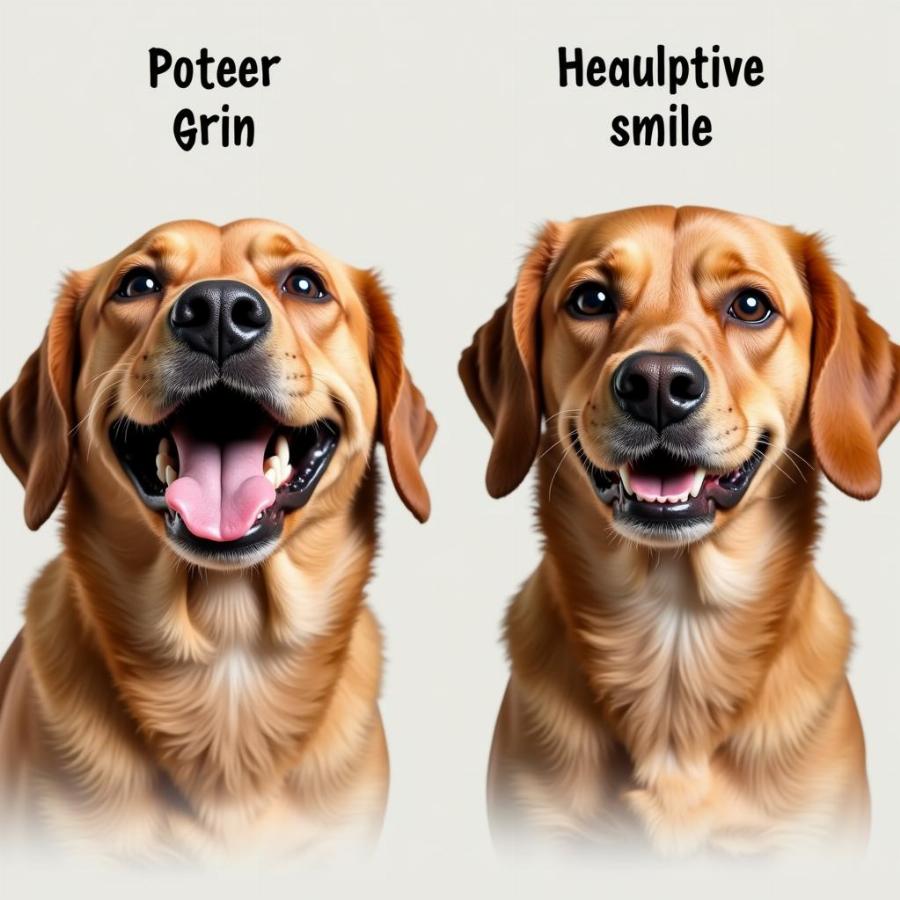The term “dog submissive grin” often leads to confusion among dog owners. Is it a sign of happiness, fear, or something else entirely? Understanding this subtle canine communication signal is crucial for building a strong bond with your furry friend. This article will delve into the nuances of the dog submissive grin, exploring its meaning, associated behaviors, and how to respond appropriately.
Decoding the Submissive Grin: Is it a Smile?
The submissive grin, sometimes referred to as a “fear grin,” isn’t always what it appears to be. While it may resemble a smile, with the lips pulled back and teeth exposed, it’s often a sign of appeasement or nervousness. Dogs use this expression to communicate that they pose no threat and are seeking to avoid conflict. It’s their way of saying, “I’m friendly, please don’t hurt me.” This is particularly important in social interactions, where dogs rely on these subtle cues to navigate their relationships with other canines and humans. Recognizing the difference between a genuine dog smile and a submissive grin is key to understanding your dog’s emotional state.
 Dog Submissive Grin vs. Real Smile
Dog Submissive Grin vs. Real Smile
Body Language Clues: More Than Just a Grin
The submissive grin rarely occurs in isolation. It’s usually accompanied by other appeasement signals, creating a cluster of behaviors that paint a clearer picture of the dog’s emotional state. These can include tucked tails, lowered ears, averted gaze, licking lips, yawning, and even rolling onto their back to expose their belly. Paying attention to the entire body language, rather than just the grin itself, is crucial for accurate interpretation. For example, a dog showing a submissive grin while also wagging its tail might be experiencing a mix of appeasement and excitement.
Why Does My Dog Show a Submissive Grin? What are the Triggers?
Various situations can trigger a submissive grin in dogs. Meeting new people or dogs, being scolded, feeling overwhelmed in a noisy environment, or even experiencing something unexpected can all elicit this response. It’s essentially a coping mechanism, allowing the dog to de-escalate potentially tense situations. Understanding these triggers can help owners create a more comfortable and supportive environment for their pets. For instance, if your dog shows a submissive grin during vet visits, it may indicate fear or anxiety. You can discuss this with your veterinarian to find ways to make the experience less stressful for your dog. Perhaps you could see if they offer a skinwalker dog smile service to make the visit less stressful.
How to Respond to a Dog’s Submissive Grin
If your dog shows a submissive grin, it’s important to respond in a calm and reassuring manner. Avoid making any sudden movements or loud noises that could further frighten them. Instead, speak softly and offer gentle strokes or pats, avoiding direct eye contact, which can be perceived as threatening. Giving your dog space and allowing them to approach you on their own terms can also be helpful. Never punish a dog for displaying a submissive grin. It’s a natural communication signal, and punishing them for it will only increase their anxiety and fear.
Recognizing the Difference: Submissive Grin vs. Aggression
It’s crucial to differentiate a submissive grin from a snarl, which is a sign of aggression. While both involve showing teeth, the context and accompanying body language are very different. A snarl is often accompanied by a stiff body posture, raised hackles, a direct stare, and growling. A submissive grin, on the other hand, is typically coupled with appeasement signals as described earlier. If you’re unsure whether your dog is displaying a submissive grin or a snarl, it’s always best to err on the side of caution and consult with a qualified dog trainer or behaviorist. You can find picture of hot dog on our website to distract your dog during training.
Conclusion: Understanding Your Dog’s Submissive Grin is Key to a Stronger Bond
The dog submissive grin is a complex communication signal that shouldn’t be misinterpreted. By understanding its meaning and associated behaviors, you can gain valuable insights into your dog’s emotional state and respond appropriately. This will not only strengthen your bond but also create a more positive and less stressful environment for your furry companion. Recognizing and respecting your dog’s subtle communication cues is a vital aspect of responsible dog ownership. Are you curious about other canine behaviors? You might be interested in knowing why does my dog bow to me.
FAQ
- Is a submissive grin a sign of happiness? No, it’s usually a sign of appeasement or nervousness.
- Should I punish my dog for grinning submissively? Absolutely not. It’s a natural communication signal.
- How can I tell the difference between a submissive grin and a snarl? Look at the accompanying body language. A snarl is often accompanied by aggression signals, while a submissive grin is paired with appeasement signals.
- What should I do if my dog shows a submissive grin? Respond calmly and reassuringly, avoid sudden movements and loud noises, and give your dog space.
- What can trigger a submissive grin? Meeting new people or dogs, being scolded, feeling overwhelmed, or experiencing something unexpected.
- Can a submissive grin be accompanied by other behaviors? Yes, it’s often coupled with appeasement signals like a tucked tail, lowered ears, and licking lips.
- Why is it important to understand the submissive grin? It helps you better understand your dog’s emotional state and respond appropriately, strengthening your bond and reducing their stress.
Further Reading
- Dog Body Language: A Comprehensive Guide
- Canine Communication: Understanding Your Dog’s Signals
Beaut Dogs is your go-to resource for reliable and in-depth information on the world of dog breeds. We provide expert guidance on dog care, from breed selection to nutrition, training, and health. For personalized support and answers to your specific questions, please contact us at [email protected]. Visit Beaut Dogs (https://beautdogs.com) today and discover the wonderful world of canine companionship!